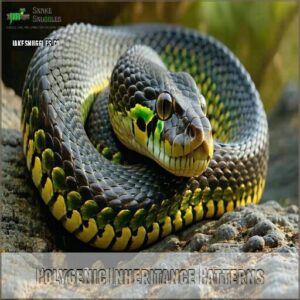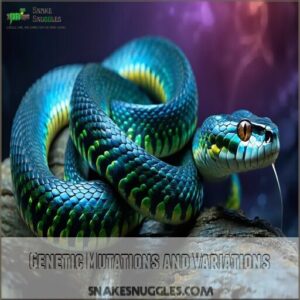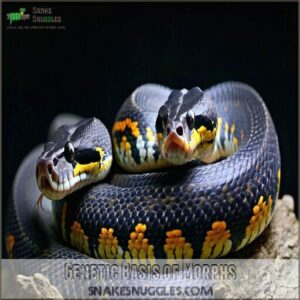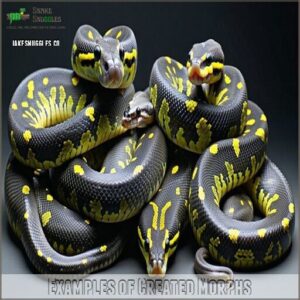This site is supported by our readers. We may earn a commission, at no cost to you, if you purchase through links.

Dominant and recessive genes interact to create unique patterns. By understanding these interactions, you can predict how offspring will look.
It’s not just about chance, you can actually influence the outcome. With a little knowledge of genetics, you’ll be breeding snakes like a pro, creating stunning color morphs.
Now, let’s crack the code of snake color pattern inheritance and uncover the secrets to creating your dream snake.
Table Of Contents
- Key Takeaways
- Snake Genetics Basics
- Color Pattern Inheritance
- Genetic Mutations and Variations
- Snake Morph Genetics
- Breeding and Genetics
- Genetic Diversity and Health
- Predicting Offspring Traits
- Frequently Asked Questions (FAQs)
- How do snake genes affect coloration and pattern?
- What are genetic color morphs in corn snakes?
- Can a snake mutation be inherited?
- Do snakes have morphs?
- What happens if you mutation a snake?
- What causes genetic diversity in ground snakes?
- How many chromosomes do snakes inherit from each parent?
- What are the recessive snake genes?
- What does 100% het mean in snakes?
- How do snakes change color with environment?
- Conclusion
Key Takeaways
- You’ll be able to predict your snake’s offspring traits by understanding how dominant and recessive genes interact to create unique color patterns and morphs.
- You can influence the outcome of your snake’s color pattern inheritance by selecting for specific traits and using tools like Punnett squares to forecast genotype probabilities.
- Genetic diversity is crucial for maintaining the health and resilience of your snakes, and you can achieve this by prioritizing genetic testing, health screening, and diversity conservation.
- You’ll discover that genetic mutations, environmental factors, and gene expression all play a role in shaping your snake’s color pattern and morphology, allowing you to create unique and stunning morphs through selective breeding.
Snake Genetics Basics
You’ll find that your snake’s unique colors and patterns come from tiny genetic instructions passed down from its parents, just like you inherited traits from your family.
Every scale, stripe, and spot on your snake is controlled by specific genes that work together like nature’s paintbrush, creating the beautiful morph you see.
Genetic Variation and Traits
Every snake’s genetic code holds a unique blueprint for their appearance.
You’ll find that genetic variation shapes everything from vibrant color morphs to intricate patterns.
Understanding snake breeding genetics is essential for predicting offspring traits.
When breeding snakes, trait inheritance follows specific rules, with gene linkage determining how colors and patterns pass to offspring.
Think of it like nature’s art palette – genetic drift and selective breeding create an endless canvas of stunning snake color pattern inheritance possibilities.
Genotype Vs Phenotype
When you’re breeding snakes, understanding the difference between genotype (DNA sequence) and phenotype (observable traits) is fundamental for success.
Your snake’s genotype determines its genetic makeup, while its phenotype shows how those genes create physical characteristics like colors and patterns through gene expression.
- You’ll feel the thrill of discovery when hidden genes reveal stunning patterns
- You’ll gain confidence knowing exactly how trait visibility works
- You’ll experience the satisfaction of predicting color inheritance accurately
Gene Expression and Inheritance
While a snake’s DNA blueprint determines its appearance, gene expression reveals how these traits come to life.
Your snake’s genetic inheritance isn’t just about what’s written in its DNA – it’s about how those genes actually work.
| Gene Factor | Expression Impact | Environmental Trigger |
|---|---|---|
| Temperature | Color intensity | Seasonal changes |
| Nutrition | Pattern development | Diet quality |
| Light exposure | Pigment activation | Day/night cycles |
You’ll notice that epigenetic factors and environmental conditions play a surprising role in how your snake’s genes express themselves, creating those stunning color patterns you love, which are influenced by environmental conditions and genetic inheritance.
Color Pattern Inheritance
You’ll discover how dominant and recessive genes work together like artists, creating the stunning patterns and colors you see in your snake’s scales.
When you understand how genes interact, you can predict what your snake’s babies will look like, making breeding feel like solving an exciting puzzle with a scientific twist.
Dominant and Recessive Genes
Your snake’s stunning patterns come from the interplay of dominant and recessive genes, nature’s color-coding system.
Gene interaction determines how these traits appear in offspring through allele effects and genetic inheritance.
- Dominant genes show up even with just one copy, like a spotlight stealing the show
- Recessive traits need two matching copies to appear
- Incomplete dominance creates unique blends of both parents
- Trait inheritance follows predictable patterns through color pattern inheritance
Polygenic Inheritance Patterns
Genetics experts often compare polygenic inheritance to an artist’s palette, where multiple genes blend together to create stunning snake patterns.
You’ll discover how complex inheritance patterns shape your snake’s unique appearance through the interaction of various genetic factors.
| Trait Type | Inheritance Pattern | Expression Result |
|---|---|---|
| Scale Pattern | Multiple genes | Varied textures |
| Color Intensity | Gene combinations | Gradient effects |
| Pattern Distribution | Environmental factors | Dynamic designs |
| Base Coloration | Polygenic blending | Mixed hues |
You’ll find that trait expression depends on multiple genetic factors working together, creating endless possibilities for your snake’s appearance.
Understanding these polygenic traits helps you predict breeding outcomes more accurately, and recognize the importance of genetic factors in shaping your snake’s unique appearance.
Gene Interaction and Color Dominance
Like a master painter’s palette, color dominance in snakes creates stunning patterns through complex gene interactions.
You’ll discover how multiple genes work together, controlling pigment synthesis and creating diverse inheritance patterns.
- Dominant genes always show their colors, even with one copy
- Recessive traits need two copies to appear
- Co-dominance lets both colors shine through
- Incomplete dominance creates beautiful blends
- Multiple genes team up in polygenic inheritance to craft unique patterns
Genetic Mutations and Variations
You’ll discover how random changes in a snake’s DNA create those jaw-dropping color patterns that make other breeders green with envy.
These genetic mutations can alter everything from scale pigmentation to pattern distribution, giving you the power to produce truly one-of-a-kind specimens in your breeding program.
Types of Genetic Mutations
Have you ever wondered how snake morphs get their stunning colors.
You’ll find several types of genetic mutations behind these variations, including point mutations that alter just a single DNA base, while gene deletions remove DNA segments completely.
Chromosome duplications create extra copies, and insertions add new genetic material, and frame shifts occur when DNA reading frames change, dramatically affecting gene expression.
These genetic variations form the foundation of the beautiful snake morphs you admire, and understanding snake morph types is essential for breeders to create unique and stunning color patterns.
Effects of Mutations on Color and Pattern
When genetic mutations occur, you’ll notice fascinating color shifts and pattern changes in your snake’s appearance.
These mutations alter how genes control pigment production and distribution, creating stunning variations.
You might see dramatic transformations – from subtle shade differences to completely new color morphs, leading to unexpected but beautiful genetic variations through trait expression.
Beneficial Mutations and Genetic Diversity
Through beneficial mutations, you’ll discover fascinating changes in snake color morphs that enhance genetic diversity.
These adaptive traits create stunning variations, from vibrant albinos to intricate patterns.
When mutation rates produce favorable outcomes, they strengthen the gene pool and create new possibilities for breeding.
You’ll find that genetic variation acts like nature’s art palette, crafting unique designs that wouldn’t exist otherwise, and this process is a key factor in the creation of stunning genetic diversity.
Snake Morph Genetics
You’ll discover how specific genes create the stunning colors and patterns you see in your favorite snake morphs, from albinos to piebalds.
When you understand how different genetic traits combine and interact, you’ll be able to predict what your snake’s babies might look like, just like solving a puzzle with DNA pieces.
Genetic Basis of Morphs
After mutations happen, you’ll want to understand what’s happening under the hood.
The genetic basis of snake color morphs comes down to specific DNA instructions. When you examine ball pythons like the Clown morph, you’re seeing the direct result of gene expression in action.
Each beautiful pattern represents a unique genetic code that dictates pigmentation pathways. Color genetics aren’t random – they’re precisely programmed by nature or selective trait inheritance.
The study of melanoma risk factors can provide valuable insights into the complex interactions between genes and environmental factors that influence color patterns in snakes.
Co-Dominant Genes and Trait Blending
You’ll explore co-dominant genes, where two traits blend, creating unique color morphs through gene blending and trait expression.
This process showcases co-dominant effects and genetic mixing, resulting in hybrid traits with incomplete dominance.
The influence of these genetic variations affects trait inheritance and genetic variation effects in snakes, demonstrating genetic mixing and its role in shaping the characteristics of the species.
Examples of Created Morphs
You create unique snake morphs through Morph Creation, combining Genetic Variants.
- Ball python morphs
- Color morphs
- Designer morphs showcase genetic variation, influencing morph inheritance in snake breeding, especially with ball pythons.
Breeding and Genetics
You’re about to learn the secrets of breeding and genetics in snakes, where you’ll discover how to predict and create unique color patterns.
By understanding the basics of genetics and selective breeding, you’ll be able to make informed decisions and breed snakes with the desired traits, using your knowledge to predict and create unique outcomes.
Selective Breeding and Genetic Variation
You’re now selecting for specific traits, like color or pattern, through breeding strategies.
Understanding genetic principles involves studying genetic testing methods.
| Trait | Genetic Variation | Breeding Strategies |
|---|---|---|
| Color | Gene editing | Selective breeding |
| Pattern | Hybridization | Trait selection |
| Scale | Genetic traits | Color genetics |
| Morph | Snake color pattern | Genetic variation |
Responsible Breeding Practices
Responsible breeding practices are key to maintaining the health and diversity of snake species.
It’s about more than just color genetics or creating unique morphs; it’s about upholding breeding ethics and the welfare of these fascinating creatures.
Here are some essential guidelines:
- Genetic testing: Screen breeding pairs to identify potential health issues and maintain the genetic health of offspring.
- Snake welfare: Prioritize the well-being of snakes, providing ideal care and conditions to support their health and natural behaviors.
- Breeder accountability: Maintain detailed records of breeding outcomes, successes, and failures to learn from experiences and make informed decisions.
- Lineage tracking: Carefully track genetic lineages to avoid inbreeding and maintain genetic diversity.
- Embrace variation: Celebrate and promote genetic variation to enhance the species’ overall health and resilience.
Genetic Diversity and Health
You’re about to learn how genetic diversity impacts your snake’s health, and it’s essential to understand this concept to breed healthy snakes.
By maintaining genetic diversity, you’ll reduce the risks of inbreeding and genetic defects, ensuring your snakes thrive with vibrant colors and patterns, which is crucial for their overall health.
Importance of Genetic Diversity
You’ll want to prioritize genetic diversity to avoid inbreeding risks, ensuring lineage diversity and hybrid vigor for ideal genetic health.
This approach is key to maintaining species traits and hereditary patterns through genetic research, which is crucial for population resilience.
Risks of Inbreeding and Genetic Defects
Inbreeding risks include genetic disorders, inbreeding depression, and harmful recessive traits.
You face health consequences, such as genetic defects, when breeding homozygous snakes.
Defect prevention is key to breeding ethics, so prioritize genetic diversity to avoid these issues, and understand that inbreeding risks are a critical concern.
Maintaining Genetic Health
To maintain genetic health, you’ll focus on:
- Genetic Testing
- Health Screening
- Gene Editing
- Diversity Conservation, ensuring heredity analysis helps prevent genetic disorders in snake color patterns, promoting genetic variation and healthy trait inheritance.
Understanding the role of genetic variation is essential in this process, as it helps in preventing genetic disorders.
Predicting Offspring Traits
You’re about to learn how to predict the traits of your snake offspring, which is a vital step in breeding.
By understanding genetics and using tools like Punnett squares, you can forecast the color patterns and morphs of your snakes with accuracy.
Punnett Squares and Genotype Probabilities
You’ll use Punnett squares to predict genotype probabilities.
Breeders can utilize online snake Punnett square calculators for complex scenarios.
| Genotype | Phenotype |
|---|---|
| BB | Dominant |
| Bb | Dominant |
| bb | Recessive |
| BB | Dominant |
| Bb | Dominant |
Punnett square analysis helps predict allele combinations and inheritance patterns.
Predicting Phenotype and Morphs
You’re predicting phenotype and morphs, using Genetic Forecasting and Morph Prediction to understand Trait Inheritance.
Color Genetics and Phenotype Modeling help you decode snake color pattern inheritance, applying genetic principles learned from Punnett squares and gene expression to forecast offspring traits accurately.
Understanding snake morphs is essential for breeders to make informed decisions about their breeding programs, utilizing Trait Inheritance principles.
Factors
You’ll consider Genetic Influence, Environmental Impact, and Color Genetics when determining factors affecting snake morphs.
Heredity principles and inheritance patterns shape their unique traits, including pattern formation and genetic variation.
Ultimately, these factors create diverse morphs through genetic traits and color genetics.
Frequently Asked Questions (FAQs)
How do snake genes affect coloration and pattern?
You’ll find that snake genes substantially impact coloration and pattern, with dominant and recessive genes interacting to create unique visual expressions, known as ‘morphs’, determining a snake’s appearance.
What are genetic color morphs in corn snakes?
You’ll discover corn snakes’ genetic color morphs are created by dominant, recessive, and polygenic traits, resulting in stunning visual expressions like albino, anerythristic, and diffused patterns.
Can a snake mutation be inherited?
You can inherit a snake mutation, as they’re passed down from parents through genes, with some mutations being dominant or recessive, influencing the snake’s appearance.
Do snakes have morphs?
You’ll notice snakes have morphs, which are unique physical variations, resulting from genetic combinations, creating diverse patterns and colors, making each snake distinct and fascinating in its appearance.
What happens if you mutation a snake?
You’ll likely see changes in the snake’s color, pattern, or scales, as mutations alter DNA sequences, potentially creating unique traits or affecting its overall health and appearance suddenly.
What causes genetic diversity in ground snakes?
You’ll find genetic diversity in ground snakes is caused by mutations, genetic drift, and gene flow, creating unique traits and variations in these slithery creatures over time naturally.
How many chromosomes do snakes inherit from each parent?
You receive half of your chromosomes, 18 pairs, from each parent, totaling 36 pairs, which determine your traits and characteristics as a snake.
What are the recessive snake genes?
You’ll discover recessive snake genes, like albinism or axanthic, require two copies to express, influencing color and pattern, and can be inherited from parents or arise through mutations, affecting appearance.
What does 100% het mean in snakes?
You’ll see "100% het" in snake breeding, meaning the snake is 100% heterozygous for a specific gene, carrying one copy of a recessive allele, but not expressing it visually.
How do snakes change color with environment?
You observe snakes changing color with environment through temperature, humidity, and light exposure, which influences gene expression and pigment production, allowing them to adapt and camouflage.
Conclusion
You’re now cutting to the chase, understanding snake color pattern inheritance is key to breeding stunning morphs.
Mastering genetics helps you predict offspring traits, and with practice, you’ll crack the code of snake color pattern inheritance, creating unique snakes with desired patterns and colors.
Making you a pro in snake color pattern inheritance.

















